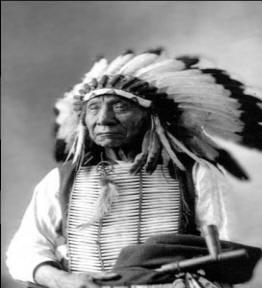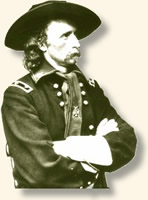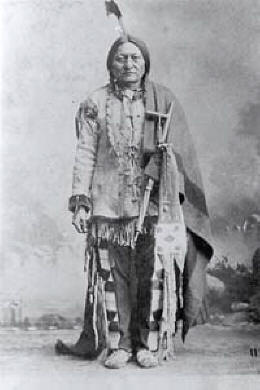
|
|
|
"Five springs ago I with many
Sioux Indians took down and packed up our tipis and moved to the Little
Bighorn river and pitched our lodges with the large cap of Sioux. "
Red Cloud 1881 |
|
|

|
Little Bighorn National Monument near
Crow Agency Montana, commemorates one of America's most famous battles.
The battle of the Little Big Horn. on June 25and26, 1876, two cultures clashed
in a life or death battle. In 1875 Sioux and Cheyenne Indians
left their reservations outraged by the continued intrusions of whites
onto their sacred lands in the black hills. They gathered in Montana with
Sitting Bull to fight for their lands. In 1876 the united states
government launched a military campaign upon a portion of the Sioux and
Cheyenne Indians who refused to live within the boundaries of the great Sioux
reservation. |
|
| To force the large Indian army onto
their reservation the army dispatched three columns to attack in
coordinate fashion. one of the columns was commanded by lt. colonel George
Armstrong Custer. General Phillip Sheridan ordered the attack from the
East, West, South. He anticipated the Indians would in eastern or south
central Montana territory. |
|
| Custer and 647 men of the 7th Calvary
were ordered along the rosebud Creek ahead of the main column.
Custer's six crow and 39 Arikara Indian scouts found the massive village
of 8000-10,000 people in the valley of the little Bighorn River. Custer
found a nearby group of 40 warriors, ignoring orders to wait he attacked
before they could alert the main party he did not realize the number of
warriors in the village numbered three times his strength. |
|
| Dividing his forces in three he sent troops
under captain Frederick Benteen to prevent their escape through the
upper valley of the Little Bighorn river. Major Marcus Reno was to pursue
the group across the river, and charge the Indian village with the
remaining troops under his command. Reno's soldiers quickly found
themselves in a battle with little hope of relief. Reno halted his
charging men before they could be trapped. He fought for ten minutes in
dismounted formation then withdrew into the timber and brush along the
river. When that position proved to be indefensible they retreated up a
hill into the bluffs east of the river, pursued by a mix of Cheyenne and
Sioux warriors. |
|
|

|
210 of Custer's men were coming toward the
other end of the village. That took the pressure of Reno's men. the
Indians crossed the river and smashed into the advancing soldiers. They
drove Custer's men in confusion. Many of them threw down their guns and
raised their hands in the air saying, " Pity us Sioux take us prisoners
" the Sioux killed all of them. The Indians chased Custer's men
across the Little Bighorn. The banks of the river were high and the Sioux
killed allot of the men there while crossing. |
| |
| On a hill the soldiers stopped and
the Sioux surrounded them. But when they caught word that a different
party of soldiers had all the women and children held prisoners they
turned around to save them. The soldiers on the hill dug up the ground and
made earthworks and the soldiers and the Sioux fought at long range. The
fight continued at long range until the Sioux saw the advancing
soldiers and then they became afraid and ran away. Meanwhile
Indians under Crazy Horse's command moved downstream and then doubled back
in a sweeping arch enveloping Custer and his men. Then they began pouring
in gunfire and arrow's. In less than an hour Custer had made the biggest military
blunder in the United States history. |
| |
| After the battle
the Indians stripped the bodies and mutilated all of the uniformed
soldiers. On June 25th 1876 one day after the battle 263 7th Calvary men
lay dead including Custer. At least sixty known Sioux and Cheyenne
warrior's were killed in the battle, but a count was not possible. |
| |
| |
| Sources:
Archive's of the west 5/9/05
<http://www.pbs.org/weta/thewest/resources
>
the
national parks service 5/9/05
<http://www.nps.gov/libi/indmem.htm>
Eye winess to
history.com 5/8/05
<http://www.eyewitnesstohistory.com/custer.htm>
The national park service
5/12/05
<http://www.nps.gov/libi/>
GOOGLE
5/12/05
<http://images.google.com/images?/q=REDCLOUD&hl=en&btng=Search+IMAGES>
|

|
| |
| |
| Tyler Pletcher
8th American History
2005 Project |


